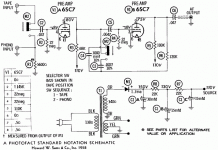John007 said:"Sounds like some EQ differences. Have you measured this?" No no, you can see the preamps i use here.
http://www.elektronky.vyjimecny.cz/?p=p_19&sName=pøedzesilovaèe
Does EQ depend on Rp?
Wavebourn said:Does EQ depend on Rp?
Yes. If it's passive RIAA than it changes the source resistance, directly changing EQ. If it's feedback RIAA, then the sweeping assumption required by easily calculated feedback (infinite gain) becomes even less tenable in a valve circuit and it changes EQ. Knowing the value of ra is important; making changes in it insignificant is vital.
Originally posted by John007
I don´t use Eq.
You do; it's called RIAA.
tubewade said:
...
I'm really enjoying all the input on this subject. It's giving me lots to consider. So far it appears that the 6DJ8/6922/6N1P/ECC88 in cascode is a very suitable valve. Some of the others mentioned seem like they might be good too but many of them are hard to obtain or are rather expensive. At any rate, I want to do all I can to keep input capacitance down. This disqualifies 6EU7, 12AX7A, 7025 and other variants and even 6SL7, even though I've used many of these over the years. My phono interconnect cable and tonearm wiring present 134pF of capacitance. Experience has shown that lowest possible capacitance makes for best sound from MM cartridges and particularly with high inductance Shure cartridges.
Thanks to everyone for all of the suggestions.
Dude,
The Bottlehead "Seduction" is 6922 based and might be quite suitable. Builders report successful mating of "Seduction" to Shure cartridges.
FWIW, the high mu, low noise, triodes are still a possibility. 😉 GE, originator of magnetic carts., developed a preamp circuit that used the inductance of the cart. to yield the HF roll off. I've attached a schematic of a Fisher designed GE style preamp. If you increase the I/P resistance to the modern 47 KOhm standard value, a small cap. has to go in parallel with the O/P to achieve the HF roll off.
Attachments
GE's circuit might have worked in 1958 but it won't work now. Magnetic cartridges are designed to work into a specific value of capacitance and resistance in order to resonate their coil inductance and produce a damped LC HF equaliser that compensates for mechanical HF losses. That's why too little capacitance on a Shure or early Ortofon can actually cause a lack of treble. Look up what the cartridge manufacturer specifies and get it right...
Other posters, including SY, have stated that MM carts. and high mu triodes are a bad "marriage", because of interaction with the Miller capacitance. Look at the 6GK5 data sheet. Even with CCS loading to extract the full mu of 78, the Miller capacitance will be well under 50 pF. 😀
Folks, the 6GK5 is a good looking tube that is plentiful.
Folks, the 6GK5 is a good looking tube that is plentiful.
Folks, the 6GK5 is a good looking tube that is plentiful.
Quiet, you've said too much!

I haven't used any 6GK5, though I've used similar triodes (e.g. 6HA5). I had a lot of problems with microphonics- is the GK better in that respect?
SY said:I haven't used any 6GK5, though I've used similar triodes (e.g. 6HA5). I had a lot of problems with microphonics- is the GK better in that respect?
Dunno. Poindexter has taken to using 6GK5s instead of 5965s in his "Machine" amp. Maybe he'll comment.
FWIW, I have seen the 'GK5 used in passive EQ phono preamp schematics.
- Status
- Not open for further replies.
- Home
- Amplifiers
- Tubes / Valves
- Best Sounding Phono Input Tube
